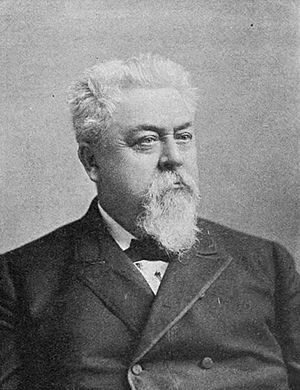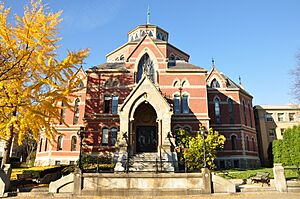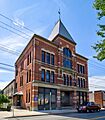William R. Walker (architect) facts for kids
Quick facts for kids
William Russell Walker
|
|
|---|---|
 |
|
| Born | April 14, 1830 |
| Died | March 11, 1905 (aged 74) |
| Nationality | American |
| Alma mater | Scholfield's Commercial College |
| Occupation | Architect |
| Spouse(s) | Eliza B. Hall |
| Practice | William R. Walker & Son Walker & Gould |
| Buildings | Robinson Hall, Equitable Building, Northbridge Memorial Town Hall |

William R. Walker (born April 14, 1830 – died March 11, 1905) was an American architect. He was from Providence, Rhode Island. He later became the main partner of a famous architecture company called William R. Walker & Son.
Contents
Early Life and Learning
William Russell Walker was born on April 14, 1830. His family lived in a part of Seekonk, Massachusetts, which is now East Providence, Rhode Island. He went to public schools and finished at Seekonk Classical Seminary in 1846.
For three years, he worked as a builder's helper in Providence. In his free time, he studied how to draw architectural plans at Scholfield's Commercial College. In 1850, he traveled to Augusta, Georgia. But he came back to Pawtucket the next year. He lived there for the rest of his life.
Becoming an Architect
In 1864, Walker started his own architecture business. His office was in the Merchants Bank Building in Providence. By 1871, he moved his office to the Reynolds Building.
In 1874, his son, W. Howard Walker, joined the company. He started as a student and helped with drawings. William Walker worked alone until 1876. Then, he made Thomas J. Gould his partner. Gould had been working for Walker since 1868. Their new company was called Walker & Gould. Around 1878, they moved into their own new building, the Vaughan Building.
In 1881, Walker & Gould split up. William Walker and his son formed a new company: William R. Walker & Son. This new company grew very big in the 1880s and 1890s. It became one of the largest architecture firms in Rhode Island.
William Walker continued to lead his company until he passed away in 1905. His son and later his grandson continued to run the firm after him.
Family and Community Life
In 1852, William Walker married Eliza B. Hall. She passed away in 1895. They had two children: George Clinton and William Howard. William Howard worked with his father in the architecture business.
Walker was also active in his community. He was a member of the town council in North Providence. He also served on the council in Pawtucket when it became its own town. He was elected to the Rhode Island general assembly for two terms. He was involved with the state militia for twenty years. He retired with the rank of major-general. Because he knew many people in politics, Walker got many projects to design public buildings across the state.
William Walker died on March 11, 1905. He is buried at Swan Point Cemetery.
Buildings Designed by William R. Walker
William R. Walker and his firms designed many important buildings. Here are some of them:
Buildings by William R. Walker (1864-1875)
- 1864 - Pawtucket Hair Cloth Mill, Central Falls, Rhode Island
- 1865 - John A. Mitchell House, Providence, Rhode Island
- 1866 - Ogden Mills House (Ocean View), Newport, Rhode Island
- 1870 - Isaac Davis House, Worcester, Massachusetts
- 1872 - Equitable Building, Providence, Rhode Island
- 1872 - Northbridge Memorial Town Hall, Whitinsville, Massachusetts
- 1872 - Alfred A. Reed, Jr. House (Cedar Hill), Warwick, Rhode Island
- 1875 - Bell Street Chapel, Providence, Rhode Island
Buildings by Walker & Gould (1876-1880)
- 1876 - Music Hall Block (Town Hall), Danielson, Connecticut
- 1876 - Robinson Hall, Brown University, Providence, Rhode Island
- 1877 - Horatio N. Campbell House, Providence, Rhode Island
- 1878 - Sanford C. Hovey House, Providence, Rhode Island
- 1879 - First Baptist Church, East Providence, Rhode Island
- 1880 - Nicholson File Office Building, Providence, Rhode Island
Images for kids








